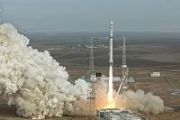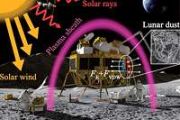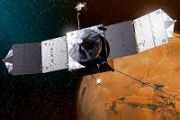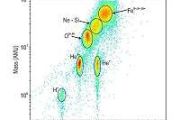
Copernical Team
Webb telescope aims to answer astronomy's 'biggest questions'
 It's been three decades in the making: the largest and most powerful telescope ever to be launched into space is finally ready to take up its orbit and beam back new clues to the origins of the Universe and Earth-like planets beyond our solar system.
NASA's James Webb Space Telescope, named for a former director of the American space agency, follows in the footsteps of the legendary Hubble -
It's been three decades in the making: the largest and most powerful telescope ever to be launched into space is finally ready to take up its orbit and beam back new clues to the origins of the Universe and Earth-like planets beyond our solar system.
NASA's James Webb Space Telescope, named for a former director of the American space agency, follows in the footsteps of the legendary Hubble - NASA's eventual farewell to tiny Mars helicopter could be emotional
 Tears most likely will flow at NASA's Jet Propulsion Laboratory in Pasadena, Calif., when the extremely successful Mars helicopter Ingenuity sends its last transmission and goes quiet on the Red Planet, according to those who have observed similar closures.
While the end of any space mission can be emotional simply because of a sudden change in routines and departure of colleagues, Ingenui
Tears most likely will flow at NASA's Jet Propulsion Laboratory in Pasadena, Calif., when the extremely successful Mars helicopter Ingenuity sends its last transmission and goes quiet on the Red Planet, according to those who have observed similar closures.
While the end of any space mission can be emotional simply because of a sudden change in routines and departure of colleagues, Ingenui Lower atmospheric processes are crucial to understanding Martian water loss
 Lower atmospheric processes, such as convection, dust storms and gravity waves, are vital to understanding how Mars lost its water, writes Erdal Yigit in a Perspective. It's widely thought that most of Mars' water was slowly lost to space as hydrogen over several billion years.
According to standard models, water molecules, broken apart by sunlight in the lower Martian atmosphere, form fre
Lower atmospheric processes, such as convection, dust storms and gravity waves, are vital to understanding how Mars lost its water, writes Erdal Yigit in a Perspective. It's widely thought that most of Mars' water was slowly lost to space as hydrogen over several billion years.
According to standard models, water molecules, broken apart by sunlight in the lower Martian atmosphere, form fre NASA Goddard helps ensure asteroid deflector hits target
 Although the chance of an asteroid impacting Earth is small, even a relatively small asteroid of about 500 feet (about 150 meters) across carries enough energy to cause widespread damage around the impact site. NASA leads efforts in the U.S. and worldwide both to detect and track potentially hazardous asteroids and to study technologies to mitigate or avoid impacts on Earth.
If an asteroid
Although the chance of an asteroid impacting Earth is small, even a relatively small asteroid of about 500 feet (about 150 meters) across carries enough energy to cause widespread damage around the impact site. NASA leads efforts in the U.S. and worldwide both to detect and track potentially hazardous asteroids and to study technologies to mitigate or avoid impacts on Earth.
If an asteroid Sol 3320: Flexibility is Key
 Curiosity is currently located within "Maria Gordon notch," which is a rather tight canyon surrounded by high rock walls located at the transition onto the Greenheugh Pediment. Her views are currently magnificent - steep walls surround Curiosity and cast some rather dramatic shadows onto the workspace.
However, despite the beautiful views, today was a sobering lesson in the complexities of
Curiosity is currently located within "Maria Gordon notch," which is a rather tight canyon surrounded by high rock walls located at the transition onto the Greenheugh Pediment. Her views are currently magnificent - steep walls surround Curiosity and cast some rather dramatic shadows onto the workspace.
However, despite the beautiful views, today was a sobering lesson in the complexities of Kleos' Patrol Mission Satellites Ready and Shipped to Launch Site
 Kleos Space S.A, a space-powered Radio Frequency Reconnaissance data-as-a- service (DaaS) company, confirms its Patrol Mission (KSF2) satellites are on track to launch onboard the
Transporter-3 SpaceX mission in January 2022, successfully passing the final technical milestone with satellite builder Innovative Solutions In Space (ISISPACE).
The Patrol Mission satellites are travelling
Kleos Space S.A, a space-powered Radio Frequency Reconnaissance data-as-a- service (DaaS) company, confirms its Patrol Mission (KSF2) satellites are on track to launch onboard the
Transporter-3 SpaceX mission in January 2022, successfully passing the final technical milestone with satellite builder Innovative Solutions In Space (ISISPACE).
The Patrol Mission satellites are travelling Los Alamos National Laboratory awards satellite mission contract to NanoAvionics US
 Smallsat mission integrator NanoAvionics US has received a mission contract by Los Alamos National Laboratory (LANL), one of the largest science and technology institutions in the world. The 12U (1U equals 10 + 10 + 10 cm3) spacecraft, about the size of a microwave oven, will host the Mini Astrophysical MeV Background Observatory (MAMBO) mission.
The goal of MAMBO is to make the best-eve
Smallsat mission integrator NanoAvionics US has received a mission contract by Los Alamos National Laboratory (LANL), one of the largest science and technology institutions in the world. The 12U (1U equals 10 + 10 + 10 cm3) spacecraft, about the size of a microwave oven, will host the Mini Astrophysical MeV Background Observatory (MAMBO) mission.
The goal of MAMBO is to make the best-eve New rocket test facility under construction in Scotland
 The UK Space Agency welcomes the news that British company Orbex is constructing a state-of-the-art rocket test facility in Kinloss, Scotland.
Ian Annett, Deputy CEO of the UK Space Agency, said:
The construction of this new facility marks another major milestone in our ambitions to become a modern, agile spacefaring nation. Orbex is an innovative spaceflight company developing its o
The UK Space Agency welcomes the news that British company Orbex is constructing a state-of-the-art rocket test facility in Kinloss, Scotland.
Ian Annett, Deputy CEO of the UK Space Agency, said:
The construction of this new facility marks another major milestone in our ambitions to become a modern, agile spacefaring nation. Orbex is an innovative spaceflight company developing its o Redwire announces supplier agreement with Terran Orbital to support satellite manufacturing
 Redwire Corporation, a global leader in mission critical space infrastructure for the next generation space economy, has announced a three-year supplier agreement with Terran Orbital, a global leader and pioneer in the development, innovation and operation of small satellites and Earth observation solutions.
Through this agreement, Redwire will deliver a range of advanced components and so
Redwire Corporation, a global leader in mission critical space infrastructure for the next generation space economy, has announced a three-year supplier agreement with Terran Orbital, a global leader and pioneer in the development, innovation and operation of small satellites and Earth observation solutions.
Through this agreement, Redwire will deliver a range of advanced components and so Spire Global selects Virgin Orbit for late-load addition to next flight
 Leading launch company Virgin Orbit, which has announced a planned business combination with special purpose acquisition company NextGen Acquisition Corp. II, has announced alongside space-based data and analytics provider Spire Global, Inc. that they have received waiver approval from the Federal Aviation Authority to include Spire on Virgin Orbit's upcoming launch. The satellite, which was int
Leading launch company Virgin Orbit, which has announced a planned business combination with special purpose acquisition company NextGen Acquisition Corp. II, has announced alongside space-based data and analytics provider Spire Global, Inc. that they have received waiver approval from the Federal Aviation Authority to include Spire on Virgin Orbit's upcoming launch. The satellite, which was int 





























